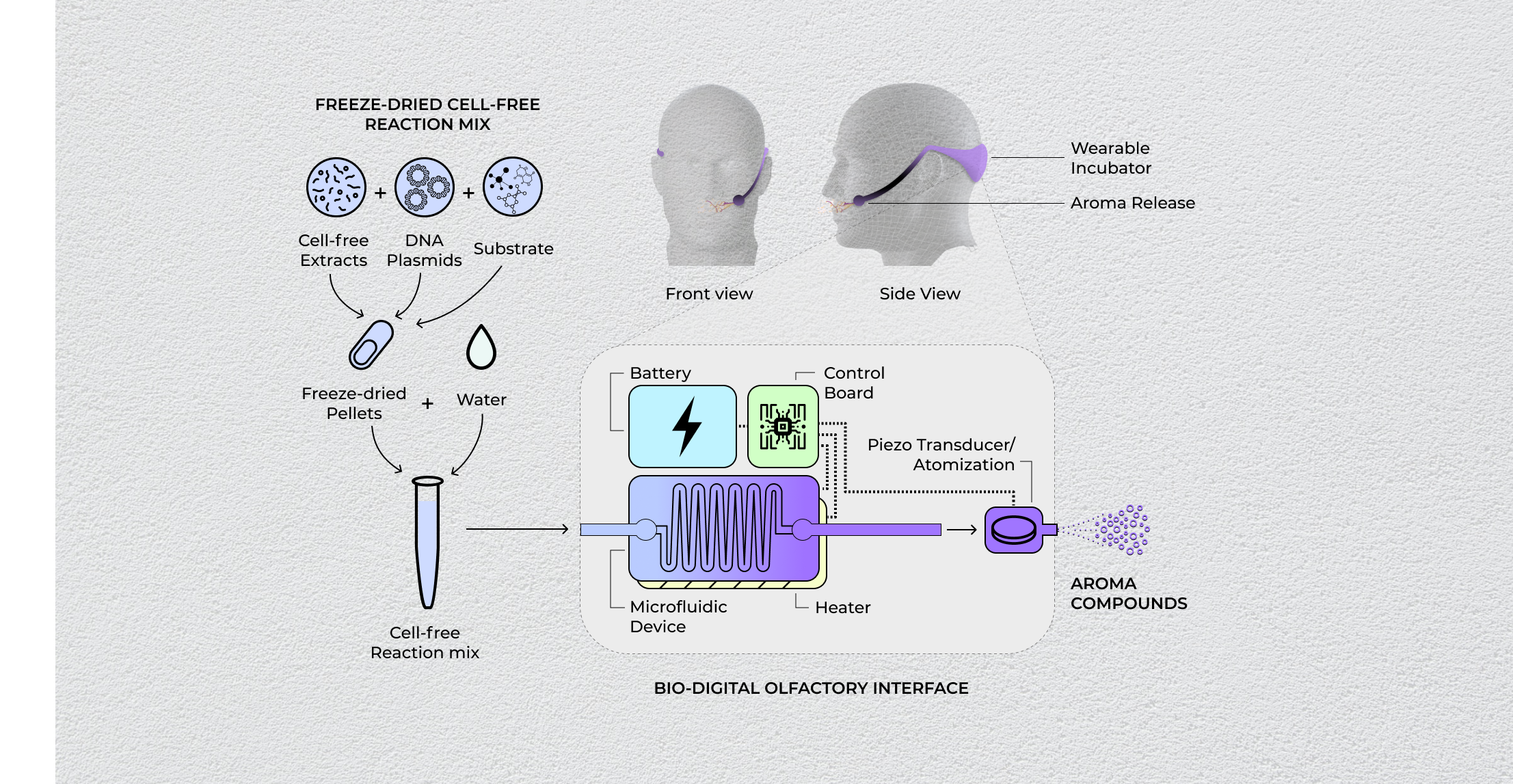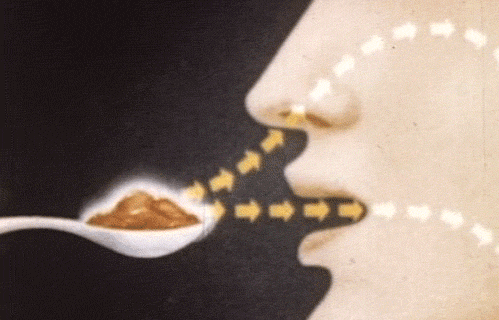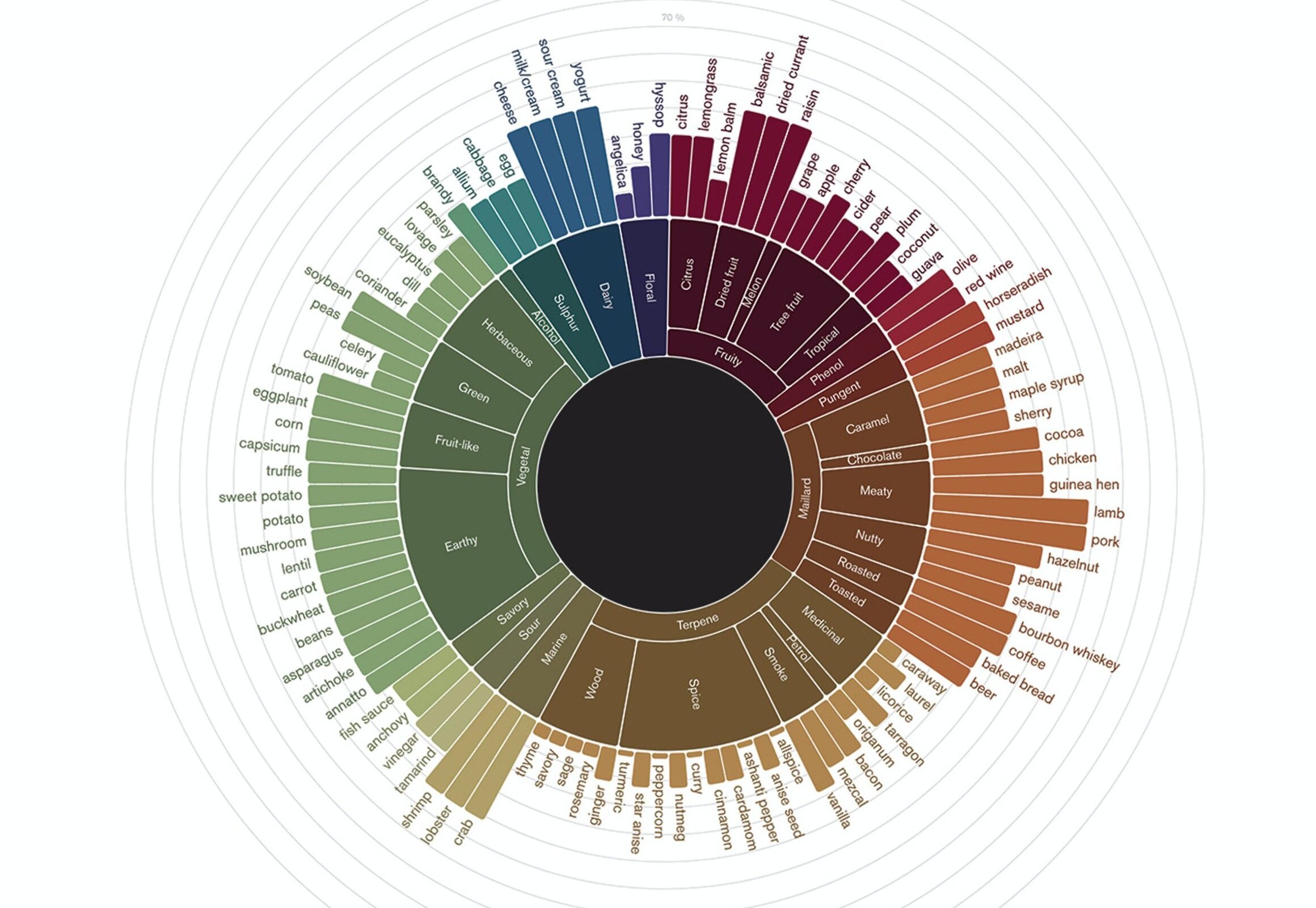on demand bio-production of aromas to enhance flavors and food experience in long-duration space exploration
Project abstract
Aromata is a personal wearable olfactory interface that leverages synthetic biology to enable astronauts to safely and conveniently produce aroma compounds on demand. These aromas are customizable based on preference, and could enhance the astronaut’s experience of flavor in space. Moreover, different aroma combinations could be paired with the crew’s limited menu, altering the ‘perceived’ flavor of the same foods; therefore, providing astronauts with more variety and novelty during long-duration missions.
Using freeze-dried cell-free (FD-CF) systems that take little space and are shelf-stable at room temperature, Aromata offers a novel approach to augment the quality and expand the variety of flavors, using minimal inputs and resources, and creating minimal waste.
Background
Food in space
With long-duration human exploration missions to Mars and beyond on the horizon, there’s an increasing need for novel food production technologies or systems that require minimal resources and produce minimal waste, while providing safe, nutritious, and tasty food for the astronauts.
Eating is an important part of crew morale and the one communal time when they share a meal together. However, astronauts found that their taste buds did not seem to be as effective when they were in space. This diminished perception of tastes and smells make food less appetizing and contribute to insufficient food intake and calorie deficit in astronauts.
Since chemosensors play a key role in the control of food intake, changes to the odor and/or taste of a food may affect its intake.
Aroma and flavor
Flavor is a complex perceptual impression of food or other substances. It consists of sensory information about taste, smell, texture and temperature. However, Of the three chemical senses, smell is the main determinant of a food item's flavor.
Five basic and universally recognized tastes include sweet, sour, bitter, salty and umami (savory) . The number of food smells, on the other hand, is unbounded; a food's flavor, therefore, can be easily altered by changing its smell while keeping its taste similar.
Flavorings are edible chemicals and extracts that alter the flavor of food and food products through the sense of smell. Three principal types of flavorings used in foods include natural flavoring substances, nature-identical flavoring substances and nature-identical flavoring substances.
Due to the high cost, or unavailability of natural flavor extracts, most commercial flavorings are "nature-identical”, which means that they are the chemical equivalent of natural flavors, but chemically synthesized rather than being extracted from source materials.
Alternatively, metabolic engineering (including enzyme technology) offers a very promising option for natural flavor biosynthesis. Both genes and enzymes involved in the biosynthesis of flavors are constantly identified, which provides insight into metabolic engineering of flavor compounds (i.e. aroma). The use of enzyme-catalyzed reactions provides higher stereoselectivity than chemical routes. It is also more cost effective and has far less negative environmental impact.
Innovation
Aromata incorporates the use of freeze-dried cell-free systems, and a built-in mircofluidic bioreactor to produce controlled amounts of aroma compounds on demand.
Freeze-dried cell-free systems
Although superior to chemical synthesis, metabolic engineering of microorganisms for flavor(aroma) compound production could be time-consuming, and involve a non-intuitive, combinatorial tuning of biosynthetic pathway variations to meet design criteria. Cell-free systems (CFS) could resolve many of these complexities, allowing for faster design–build–test cycles and direct manipulation of the reaction.
Components of a cell-free protein
synthesis reaction: (extract, supplements, and a DNA template) with the key reactions that occur when they are combined.
Melinek et al., “Toward a Roadmap for Cell-Free Synthesis in Bioprocessing.”
In addition, by compressing buffers, cellular machinery, and molecular instructions all into a single freeze-dried (FD) reaction pellet, astronauts would be able to activate aroma compounds in space on-demand, only by adding water within a few hours, and without the need for specialized equipment and skill.
BioBitsTM kits: Freeze-dried educational kits.
A) FD-CF demonstrations require only the addition of water to the supplied reactions and incubation for 1 to 20 hours at 25° to 37°C. (B) With the DNA template and any substrate molecules provided with the FD-CF reaction, the students just have to add water to run a number of bioscience activities.
A cell-free approach was used to produce certain aroma compounds in the lab, proving that it is possible to produce a variety of compounds and develops protocols to produce more complex aroma combinations (aroma recipes).
Fragrance-generating enzymes as olfactory outputs
(A) Using FD-CF reactions, we manufactured enzymes that can generate various smells from the Saccharomyces cerevisiae acetyltransferase ATF1. (B) Production of fragrance molecules after substrate addition to overnight FD-CF reactions of ATF1, as detected by headspace GC-MS. Values represent averages, and error bars represent SDs of n = 3 biological replicates.
Microfluidic Bioreactor
A microfluidic bioreactor inside the device incubates the CF systems, once they’ve been activated with water.
HCI
Specific aims
Express a single aroma compound
in E. coli
in a cell-free system
Create an aroma pack: a complex food aroma recipe
Multiplexing multiple pathways in one cell-free system
Combinatorial approach
Design and prototype a user centric device, as well as method of use and operation tailored to the needs of astronauts







